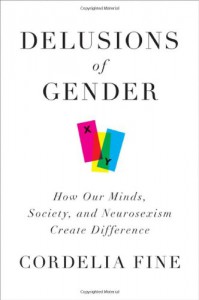Delusions of Gender by Cordelia Fine

We’ve all encountered those pop science books, the ones that claim “hardwired” differences between male and female minds. Cordelia Fine has seen them too, but instead of simply accepting their assertions because they sound scientific, she delved into the research, tracking down the studies that purportedly establish these claims, as well as the substantial body of research showing quite the opposite. The result is this book. It is not pop science – there is nothing dumbed-down about it, and Dr. Fine’s points are supported by extensive research, included in the endnotes and bibliography – but nor is it dry, academic material. It is aimed at the intelligent reader who may or may not have a science background; I do not, but found the book fascinating, clear, and well-organized, with strong, logical analysis of the research and even a few moments of humor.
There is a strange tendency to view differences in current achievements between men and women as proof of inherently different abilities. This was true even in the 19th century, when women lacked the educational tools and the freedom to even begin to compete. Regardless of that small detail and the fact that gender roles in society continue to change, there are always those who claim that whatever women are achieving at the moment is the absolute biologically-determined limit. Now that we have at least officially achieved equality, some writers continue to make the same claims, conveniently setting aside differences in expectations, role models, and differing social demands on women’s time (women still do the bulk of the housework – even when they’re employed and their male partners are not!). This book deals with three main areas of gender research, to see what has actually been proven.
First, tweaking the environment can eliminate gender differences in test performance: tell women before a test that they as good at math as men, and they will be; tell them they’re biologically limited, and they fall behind. Show a commercial featuring women behaving in stereotypical ways before a math test, and women’s performance goes down. On a test in mental rotation of objects, tell participants that it predicts ability in fields such as engineering and navigation, and men do much better; say it predicts ability in clothing design and interior decoration, and men’s scores go down. On the other hand, remind participants that women are supposed to be better at empathizing than men, and they’ll do better at recognizing emotions. Women report more empathetic ability than men do, but in in real-life situations, no gender differences in mind-reading have been found. Women will respond to an ethical dilemma in more caring ways than men after an exercise forcing participants to think about gender, but both genders will respond in the same way after non-gender-related exercises. In other words, emphasizing gender makes us more stereotypical; it reminds us how we are supposed to behave and what our strengths and weaknesses should be. And if a simple reminder right before a test can alter performance, how much more growing up in a world with constant reminders of gender?
Second, the book takes on brain research that has been used to “prove” inherent differences between men and women. We should approach this research with a healthy dose of skepticism, for several reasons. This field is still experimental, tends to use very small sample sizes, and the actual studies often show much less than (or something completely different from) what pop science authors claim. (In one particularly egregious example, an author drew gender differences from a study with only female participants.) But the unsuspecting public tends to take as immutable fact anything labeled “brain science,” even if the results aren’t borne out in observed human behavior. Nevertheless, every generation seems to have its own pseudoscientific theories for why women are inferior, whether it’s that women’s smaller bodies or energy-sapping ovaries prevent sustained mental activity, or that men use one brain hemisphere at a time while women use both (a theory that will presumably be revised based on research showing that interaction between the hemispheres is associated with strong math abilities).
Third, there’s the section on gender development in children. Many parents, finding that their daughters love princess costumes and their sons toy trucks without need for parental encouragement, conclude that these differences must be hardwired. But unless your children consume no media and interact with no one outside the family, it’s impossible to prevent their picking up on societal expectations, and kids are always searching for information about how the world works and how to categorize themselves within it. That’s leaving aside unconscious differences in the way parents (and researchers) treat children: for instances, studies have found mothers talking more to baby girls than baby boys, and underestimating girls’ crawling abilities while overestimating boys’.
One can see, then, how all of these areas work together to create continuing perceptions of different abilities. As the author puts it: “So far, the items on that list of brain differences that are thought to explain the gender status quo have always, in the end, been crossed off. But before this happens, speculation becomes elevated to the status of fact, especially in the hands of some popular writers. Once in the public domain these supposed facts about male and female brains become part of the culture, often lingering on well past their best-by dates. Here, they reinforce and legitimate the gender stereotypes that interact with our minds, helping to create the very gender inequalities that the neuroscientific claims seek to explain.”
And I’ve only scratched the surface of the information found in this book. Definitely a must-read for anyone interested in gender (and with the possible added benefit of reducing your own stereotypical behavior!).






 7
7
 1
1